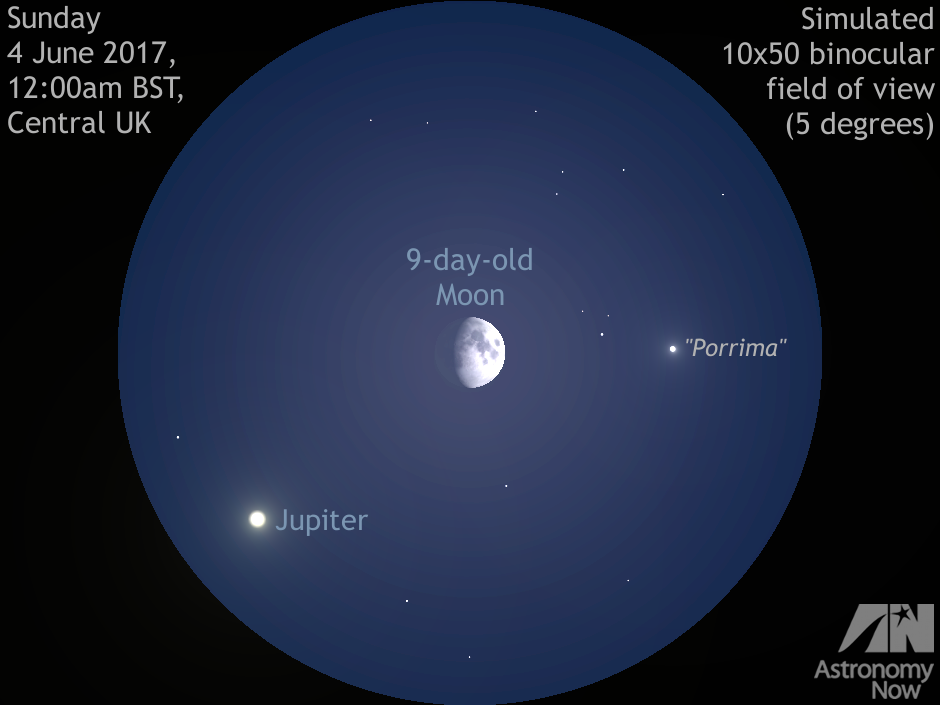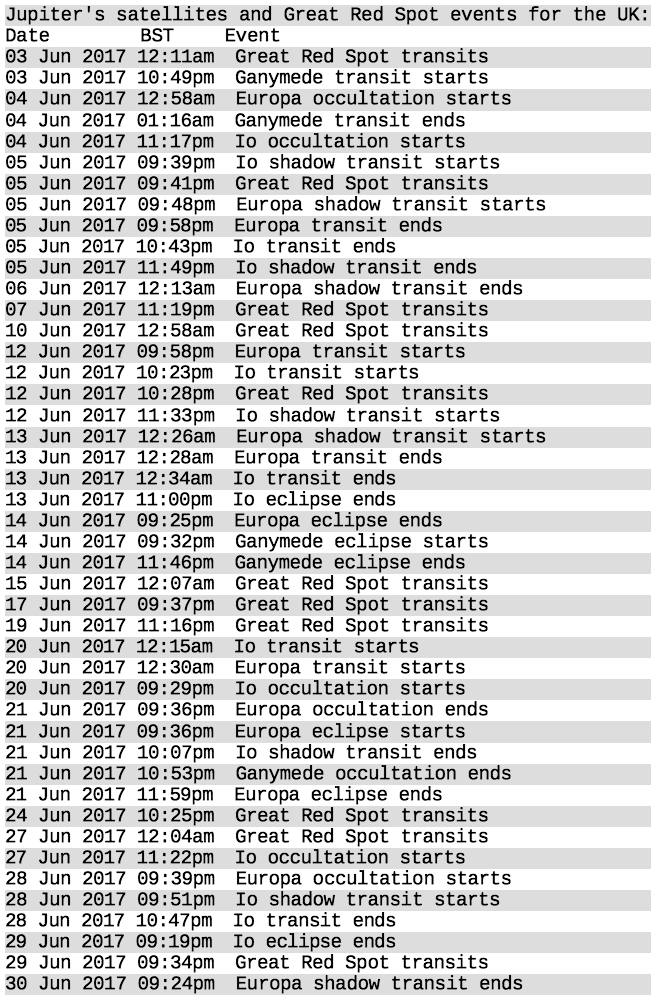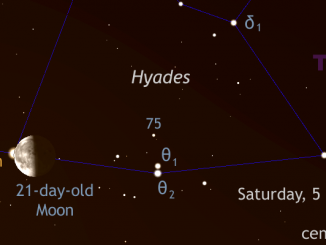
As the late evening of Saturday 3 June segues into the early hours of 4 June in the UK, the waxing nine-day-old Moon lies less than 2 degrees to the upper right of Jupiter low in the southwest. This conjunction of the Solar System’s largest planet and gibbous Moon makes an attractive pairing in a typical binocular, while a telescope magnifying less than about 25× permits you to see both the Moon and Jupiter in the same field of view.
Look carefully at the scene depicted above in, say, a 10×50 binocular and you will see a magnitude +2.7 star about three lunar widths to the right of the Moon. Known as gamma (γ) Virginis, this star was accually occulted (hidden) by the Moon some four hours before the conjunction shown above.
Occultation of gamma (γ) Virginis
Otherwise known by its proper names of Porrima or Arich, gamma Virginis is Virgo’s second-brightest star after Spica. Since Porrima sits just 2¾ degrees north of the ecliptic, it lies in the band of sky where it is periodically hidden by the Moon. The lunar occultation of Porrima on 3 June is visible from a broad swathe of the Northern Hemisphere including northeastern Canada, Greenland, Iceland, Europe and North Africa.
The 3 June event is, however, a daylight phenomenon for locations west of a line passing from Finland, through Germany, France and Spain. For skywatchers in the heart of the British Isles, the disappearance of Porrima at the Moon’s darkened limb in the south-southeast occurs close to 7:43pm BST, some two hours before sunset — a challenging observation requiring a medium-to-large ’scope at a moderate magnification. The star reappears at the Moon’s bright limb by 9:01pm BST (still in daylight) for the centre of the UK.
Elsewhere in the British Isles, the disappearance/reappearance times of Porrima occur at 7:46pm/9:06pm in London and 7:43pm/8:58pm in Edinburgh (all times BST). For observers with instruments on pre-aligned GoTo mounts or equatorials with setting circles, the J2017.4 coordinates of Porrima are α=12h 42.5m, δ=-01° 33′ (α=12h 41.6m, δ=-01° 27′ J2000.0).
The next lunar occultation of gamma Virginis visible from the UK in a dark(ish) sky occurs close to 9pm BST on 24 August 2017, very low in the western sky.
Porrima — fine double star
As seen from a large swathe of Central and Eastern Europe, North Africa, Southern Russia into Asia, on 3 June the Moon glides over gamma Virginis when the pair are high in a dark sky. In good seeing, a quality 4-inch (10-cm) telescope or larger at magnifications of around 200× splits Porrima into two almost identical magnitude +3.5 yellow-white stars separated by 2.6 arcseconds. The pair orbit one another in a highly elliptical path once every 169 years and lie about 38 light-years away. The separation of the two stars is widening, so the twin stars of Porrima will be easier to resolve in smaller telescopes at lesser magnifications over the next few decades.
 Jupiter and its Galilean moons in June
Jupiter and its Galilean moons in June
The largest planet lies highest in the southern sky of the UK at sunset at the beginning of this month, so by the time it is visible to the naked eye its altitude is already decreasing. Jovian watchers should have their ‘scopes ready by sundown to view any shadow transits of the planet’s four large Galilean moons, or their occultations and eclipses by Jupiter.
A summary of all the Jovian events visible from the British Isles in June is shown in the accompanying table. (Click the graphic for a full-size version suitable for printing.)
Great Red Spot
Jupiter’s Great Red Spot (GRS) puts on an appearance at times suitable for observing from the UK during June, also shown in the accompanying table. The GRS is said to transit when it lies on an imaginary line joining Jupiter’s north and south poles.
Owing to the planet’s fast rotation (at the latitude of the Great Red Spot Jupiter takes little more than 9h 55m to make one revolution), the GRS is only well seen for up to an hour either side of the transit time.

Predictions for the start and end times of Galilean shadow transits, plus information on their eclipses and occultations for any given date in a slightly more user friendly format may also be obtained through our Almanac.
To see the satellite events for any given day, ensure that the Almanac’s ‘Add phenomena of Jupiter?’ checkbox is ticked. Like the Great Red Spot predictions, all Galilean moon phenomena are in Universal Time (UT), so observers in the UK should currently add one hour for British Summer Time. For help using the Almanac, see this article.



